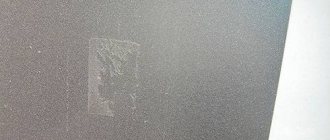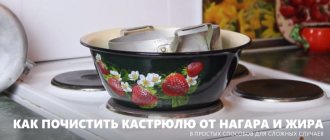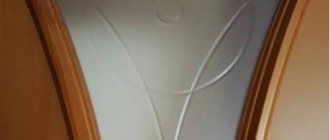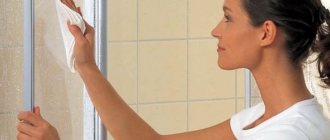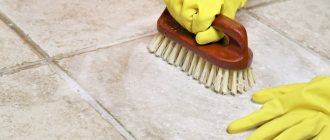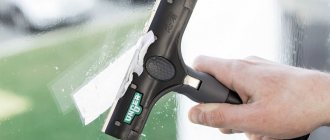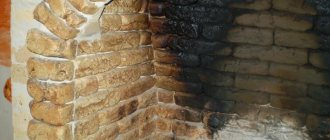Our review is dedicated to those who were unable to protect windows and mirrors from such a highly durable building material with a chemical composition as a primer. Depending on its intended purpose, the priming agent consists of natural or synthetic substances, various pigments, and fillers that provide reliable adhesion.
The mixture is applied to concrete and brick walls for subsequent plastering, painting, gluing tiles, tiles, or wallpaper. That is, this solution is durable, dries quickly and forms strong adhesion to surfaces.
What is the root of the problem?
All primer solutions are designed to improve the adhesive (cohesive) qualities of bases and coatings; almost no repairs are carried out without them in our time. It is on such compositions that it depends how long and firmly they will hold, for example, materials such as wallpaper, tiles, paint, putty mixtures, etc.
Each soil must contain a diluting base - a special solvent or purified water. And to achieve the highest quality adhesion, special polymer fillers are added.
Therefore, as long as these polymers are dissolved in liquid, stains or splashes can be washed off easily and quickly. Within half an hour after applying the primer to any surface, it is possible to wash it with a damp sponge or rag, and after this time the liquid will begin to gradually evaporate and this component will crystallize. You can learn more about how long it takes for the primer to dry in our review.
So, if in the first 2-3 days the problem can still be solved in some artisanal way, of course, this will be quite difficult, then after a couple of weeks it will be almost impossible to get rid of the blot without traces and harm to the surface, the chances of a successful outcome are approximately equal to to 20–30%.
In our case, you shouldn’t despair, the glass material is very durable and acid-resistant, so you just need to choose the right way to wash the primer from the glass.
How to wash the primer used for wallpapering walls?
This composition is used to improve adhesion between wallpaper and the base of the walls. Such a solution, regardless of the manufacturer, is washed off quite easily. It is best to immediately remove fresh stains of this primer with a dry and then a damp cloth before it hardens. If this has not been done, you will have to tinker a little. At the polymerization stage, you will only have to use a damp sponge or washcloth.
When the primer solution hardens on the surface, you have to apply some effort. It is recommended to use various abrasive compounds for this purpose. First, moisten the contaminated area with the product and wait until the stain swells. Then, when the primer begins to soften, simply wipe off the composition with a clean rag or sponge. There is no need to use a scraper or blade. Then this place is washed with water, and that’s it, there will be no stains or streaks left.
Preventive measures
The contact of any primer on surfaces not intended for treatment delays and complicates repairs, so it is easier to prevent unnecessary contamination than to look for methods, tools and means to remove stains, splashes, drips, and stains from the primer.
REMEMBER! It is easier to prevent a problem in advance than to fix it later. For some unknown reason, this rule is well remembered only after several hours of removing blots using all kinds of methods and means.
Even before making repairs, protect all surfaces from various contaminants using film, cellophane, cloth, connecting the edges with tape or special masking tape.
For example, shrink film is suitable for protecting glass. The material is quite thin and will not “block” sunlight. For tiles, laminate or linoleum, you can use any water-repellent material. Such affordable and simple measures will make it possible to complete all finishing work without the slightest consequences - frozen putty mixtures on the windows, residues of glue, paint or primer.
But still, even the most experienced painters are not immune from the primer getting on the glass during the work performed. There is nothing wrong with such an oversight, if you know the right way to fix everything, the main thing is not to miss the moment. In this article, we will offer several effective, economical and safe options for removing primer from glass at your discretion.
Methods for removing dirt vary depending on the degree of contamination, type, composition of the primer, its concentration, thickness of the resulting layer, drying stage, and so on.
Therefore, first determine the degree of your contamination and then prepare the necessary cleaning agents, detergents and tools, this can be water, soda, vinegar, paint thinner, glass and other surface cleaners, rags of different densities, washcloths with different coatings, sponges, knives , blades, scrapers, protective equipment.
Pollution Prevention
When painting, preparation is the most important step in the process, making cleanup faster and easier after painting is complete. If the furniture cannot be removed from the room, move it to the center of the room and cover it with oilcloth. Do the same with radiators on the walls - a thorough coating will eliminate the need for complex cleaning.
Expert opinion
Natalya Osadchaya
When painting the ceiling, don't forget to cover the light fixtures; Be careful that the lamp does not burn the oilcloth.
It is better to cover the floor with a double layer, and the 2nd layer should ideally be made of a more durable material. Place cardboard boxes or old sheets on the oilcloth to prevent any leftover plaster from turning into dirt. This cardboard or fabric layer also prevents the oilcloth from tearing when stirrups are used.
On windows it is enough to cover the glass; it is easier to clean the primer from the window frames and doors (it is better to cover the MDF door trims, they are easy to damage during cleaning). Covering the frames takes a lot of time and also makes it impossible to open the windows.
Important! Sockets and switches can be sealed with tape, but it is important that water does not get into them. Therefore, it is safer to turn off the fuses.
Effective and simple methods
If you did not carry out the repair yourself and did not follow the entire process, then in this case, determining which particular composition was applied is quite problematic, so choosing a method and means to remove the primer stain will need to be done using the “scientific poke” method, that is, trying all the options one by one .
Maceration
- The most cost-effective and easiest option: generously moisten a thick cloth with water, wipe off the primer and rub the glass until it shines with a dry cloth or soft paper. But this method is suitable for instantly responding to excess material getting on the glass, since it is designed to firmly connect surfaces and dries relatively quickly, in about half an hour.
- If the primer has dried well, cover it with a wet cloth and wait half an hour for it to soak in water and swell. It is recommended to dampen the cloth every 5-7 minutes to keep it wet at all times. Then, carefully in one direction, without pressing too hard, so as not to scratch the glass, clean it off with a blade. Then wipe the glass with a damp cloth.
Wedge with wedge - erase the soil
If the primer got on a mirror or window not so long ago, then apply a little of the same primer to dry stains and let the dried layer soak, then wipe off both layers with a well-wetted cloth and rub the glass with a dry cloth.
The whole problem with this method is that before you start wiping off the blot, you need to accurately determine the nature of the solution, and this is not always possible.
Abrasive sponge
You can use an abrasive sponge (with a fine powder), wet it with water, apply it to the stains, removing them; although this process is lengthy, it is effective and safe for the glass surface. If the stain is already old, then naturally it will not come off on the first try.
The problem area should be soaked:
- It is necessary to moisten the sponge in hot water.
- Apply to the blot and leave for 15-20 minutes. Periodically you need to wet the sponge so that it is always hot.
- After soaking, try to wipe off the dirt.
Scraper application
A special scraper can make your task easier if you use it correctly. It is necessary to check the edge of the knife, how sharp it is, whether there are any malfunctions in it, it is important to hold it at an angle of 30-45 degrees, promptly clean it from accumulated dirt and wipe it dry.
Clean off streaks soaked in water carefully, without using unnecessary force. Rub any missed areas with dishwashing detergent and wipe the surface clean with a damp cloth.
Nylon mesh
If after painting work there are droplets of primer left on the glass, then a nylon mesh will help you. When moving up and down, dirt is easily cleaned off. Then remove traces of dust with a damp cloth.
Home Remedies
- Ordinary table soda can replace dish cleaning products. Pour a large amount of baking soda onto a wet sponge and remove the dried primer from the glass, then wipe off any remaining dirt and stains with a wet material and rub with a dry cloth.
- Vinegar is used to clean glass and acid-resistant tiles. Apply the undiluted product to the dried soil, wait 10-15 minutes, then wash off with cold water. This process will need to be carried out several times.
What products and tools will help remove primer from glass?
You can clean the surface of window glass from a solution that improves the adhesion of the base to the decorative finish using the following available and special means:
- white spirit, acentone and other solvents;
- regular tap water;
- household detergents;
- strong chemical household products;
- baking soda, acetic acid and other traditional methods.
The tools you need to prepare are an abrasive sponge, scraper, sponge or blade. However, when choosing a specific product, you should take into account the type of primer that was used to stain the glass.
Special equipment
The next option for wiping the primer off glass is using low-foaming, but active glass cleaning substances.
The most effective cleaners called:
- "Dopomat";
- "Veroclean";
- "ATLAS SZOR";
- Corvette;
- "Hodrupa A" and others.
These products are used to treat fragile surfaces as follows: 10 ml of concentrate is diluted in 1 liter of cool water, the resulting solution is applied to the stains with a washcloth, washed off with cold water after a while, and wiped dry.
When using concentrated substances, you need to take precautions, so work only with gloves, do not leave the solution on the glass for a long time or unattended.
Solvents
How to wash primer from window glass more efficiently and quickly? Of course, specialized paint thinners such as acetone, white spirit, gasoline, alcohol, ethyl acetate, thinner 646 and turpentine. Wet the contaminated glass with any of the above solvents using a sponge, wait a while, wipe off the stains, and rinse it off with a damp cloth.
"Mister Muscle"
The well-known “Mr. Muscle” or other similar window cleaning liquids can also solve your problem, and if you also use such a liquid paired with a hard sponge to improve the effect, you will get a satisfactory result faster and easier. Spray the product you have on the glass, give it a little time and rub the surface with an easily absorbent cloth.
All work must be carried out exclusively with rubber gloves, as there is a high risk of serious burns.
Professional chemistry
Cleaning with professional chemicals promises an immediate effect, but the components they contain negatively affect furniture and other surfaces. Most of them contain acidic compounds. Let's look at the most popular substances:
- Veroclean. This drug must be diluted at the rate of 1 liter of product per 5 liters of cold water.
- Powerfix. This drug must be diluted at the rate of 2 liters of the substance per 5 liters of plain water.
- Hodrupa. This drug must be diluted at the rate of 200 ml per 8 liters of cold water.
- Atlas Zsop. This drug must be diluted at the rate of 1 liter of substance per 5 liters of plain water.
- Dopomat. This drug must be diluted at the rate of 300 ml of product per 8 liters of cold water.
If you decide to deal with the problem with chemicals, then you need to take precautions. Any of these substances will easily corrode the skin of your hands, and the vapors may cause slight dizziness and even discomfort. Therefore, you need to wear rubber gloves and a respirator.
Reference! Professional chemicals are most often used to clean large areas of dirt. They are universal, sold in large cans and are not suitable for home use.
Removing soil with a steam cleaner
A steam cleaner is often used to clean dried splashes, blots and smudges. It is effectively used in cleaning primer solutions from the porous structure of tiles, but it is strictly prohibited to be used on glass and mirror substrates. But when working with glazed tiles, you also need to act carefully, since the material is extremely unpredictable.
The process of working with such a tool is simple:
- direct the steam stream to the problem area;
- treat the area with a brush, preferably with hard bristles.
RECOMMENDATION! The problem area must first be treated with a solvent. This will help minimize damage during mechanical cleaning, and the tile will not lose its presentable appearance due to persistent and prolonged friction.
Chemicals
If none of the above helps get rid of primer stains, use the "big guns" - household chemicals - to clean up problematic stains. For window glass, any product can be used; for tiles, it is better to choose an alkaline-based cleaner.
We recommend: Implementing ideas from IKEA in your home with your own hands
List of cleaners:
- Dopomat;
- Hodrupa A;
- ATLAS SZOR;
- Veroclean;
- Corvette;
Powerfix is an acidic product, all others are alkaline. Corvette can be used to remove stains from porcelain tiles. All of these products are professional and highly concentrated, so before use they must be diluted according to the instructions. To get rid of stains, choose con. After use, the surface should be thoroughly rinsed with water.
Useful tips
Having chosen any of the methods that suit you, remember that safe working conditions, first of all, no perfectly executed repair can compare with lost health and injuries.
Therefore IMPORTANT:
- Before performing work in a house or apartment, make sure that the room is well and gently ventilated, avoiding drafts, since the composition of cement, starting or finishing putty, and primer does not have a favorable effect on the respiratory tract.
- Choose long-sleeved clothing made from simple, non-synthetic fabrics, don’t neglect a cap or scarf to cover your head, protect your hand skin from allergic reactions, wear work gloves that fit your size.
- To avoid inhaling dust and toxic, caustic, poisonous odors of auxiliary fluids, which, if they enter the lungs, can cause allergic symptoms, use a respirator or protective mask.
After familiarizing yourself with the features of working with primer outlined in our article, you will be able to avoid unpleasant situations, protect your health and easily complete your tasks.
How to remove acrylic type primer from window glass?
This type of primer also does not cause any difficulty in removal. It can be easily removed from absolutely any smooth surface. Glass and tile are no exception. Any stains that form are removed immediately with a wet cloth, making sure that no streaks remain. No chemical reagents are required. This also applies to abrasives. Acrylic primer, which contains dyes, is difficult to remove. They cause some difficulties in removal. To get rid of the colored composition, it is recommended to use a solvent such as white spirit. Pre-treatment of the glass surface with hot water, but not warm, helps to quickly deal with stains.
How can you make the cleaning process easier?
To ensure the removal is as efficient as possible and you don’t have to spend a long time on the glass with a blade that can scratch it, it is recommended to use organic solvents. They contain esters. These compounds neutralize the effect of the adhesive primer. Proper preparation of the stain before removing any remaining product with a blade allows you to achieve the desired result.
It is performed according to the following scheme:
- in organic solvents, moisten a piece of clean cloth and apply it to the stain;
- wait about half an hour and remove the rag from the surface of the glass.
Now that the primer has acquired a jelly-like shape, use the blade. In this case, it can be replaced with a spatula. Re-processing will no longer be required. To complete the cleaning, wipe the glass with a sponge soaked in a soapy solution and then wipe it with a damp, clean cloth.
What is a primer
Understanding the properties of the material makes it easier to figure out how to remove it from the window base in the house. Primer is used for various types of work to increase the adhesive properties of the surface. When the moisture entering the composition evaporates during the drying process, it becomes difficult to remove the layer; it cannot be dissolved. It becomes hardened cement, which is also difficult to dissolve.
Primer is used for various types of work to increase the adhesive properties of the surface.
Use of strong cleaning compounds
Not in all cases, the methods described above give an effective result; the adhesion may be so strong that more aggressive means will need to be used. Experts note the following brands as high-quality and effective:
- Veroclean;
- Powerfix;
- Hodrupa;
- Atlas Zsop;
- Dopomat;
- Corvette.
When using these products, the technician must follow safety rules. Wear safety glasses and gloves and ensure good ventilation in the room.
Make sure that the substance does not get on the plastic window sill; the material may be damaged by chemical elements.
The adhesion may be so strong that more aggressive means must be used.
General information
Primer - what is it and what is it for?
If you do not use such a substance when carrying out renovation work in your home, the walls may soon begin to crack, and the wallpaper will begin to fall off. This will not only bring all the efforts of the master to naught, but will also significantly affect the quality of life, as well as the comfort of the person who lives in such a house. It is for this reason that construction experts constantly recommend treating walls with a primer before finishing them. Another thing worth noting is the fact that such material must have a quality certificate in order to demonstrate the highest possible degree of effectiveness.
How to prevent primer stains on floors and walls
Don’t think that painting is a simple matter. Often, even very experienced builders begin to stain tiles or linoleum on the floor, as well as window glass or window sills with primer. And if such stains should not be washed off immediately, then after a while they will turn into a rather complex problem. To prevent such difficulties from occurring after renovation work in a country house or even in a city apartment, you can try to protect the surfaces as much as possible from the risk of staining them with a primer. How to do this?
The following rules should be adhered to when performing all repair work inside a country cottage or even within a city apartment:
In order to prevent the solution from getting on all kinds of surfaces that do not need priming, you should completely cover them with cellophane. The joints should be taped with simple stationery tape.- To protect yourself from various complications and allergic reactions associated with human health, you should definitely perform all work in a special mask and clothing. You should also regularly ventilate the room, because the primer has a strong, unpleasant odor.
And now let's look at how to remove stains.


